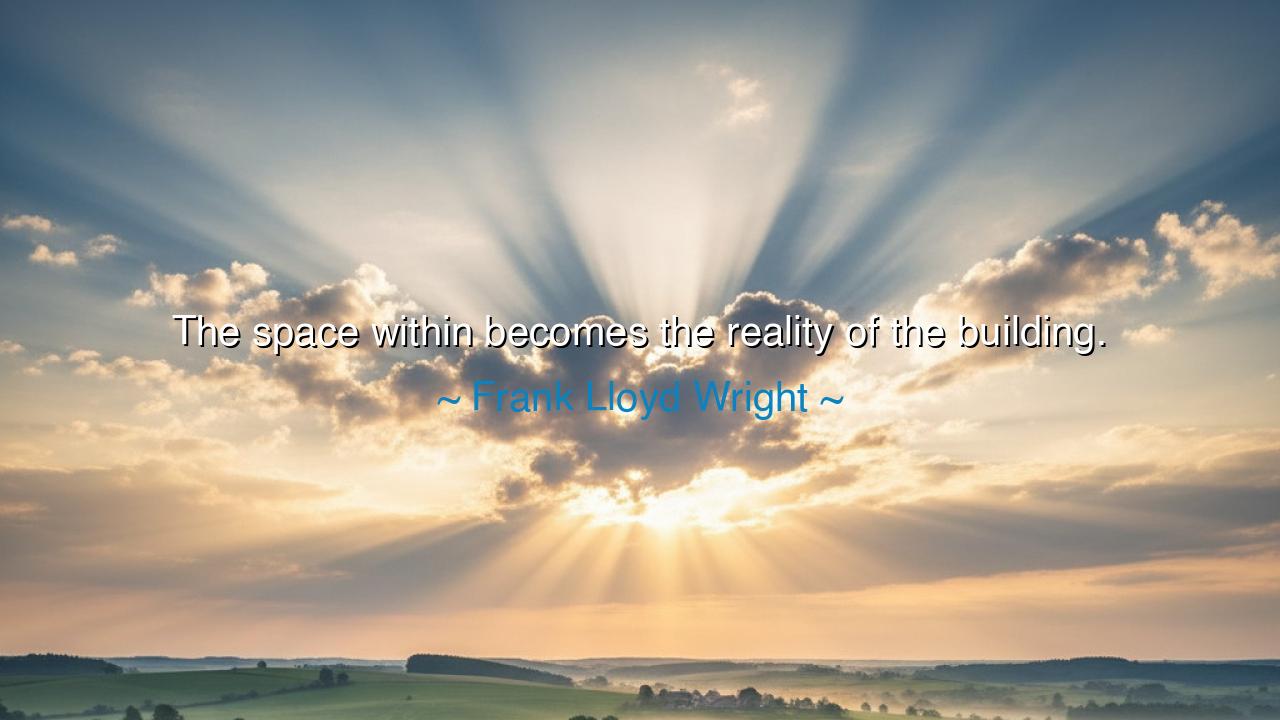
The space within becomes the reality of the building.






"The space within becomes the reality of the building." – Frank Lloyd Wright
So spoke Frank Lloyd Wright, the master who taught that architecture is not the art of walls and roofs, but of the life that breathes between them. When he said, “The space within becomes the reality of the building,” he was speaking a truth older than stone and deeper than geometry — that true creation is not found in form alone, but in the spirit that form holds. To Wright, the essence of a building was not in its appearance, but in the invisible harmony it created between human and nature, between soul and shelter. He saw what few had dared to see: that emptiness itself, when shaped with wisdom, becomes sacred.
The origin of this idea lay in Wright’s lifelong devotion to organic architecture — the belief that a building should grow naturally from its environment, like a tree rising from the soil. In an age when others worshiped ornament and monumentality, Wright turned his gaze inward, toward the inner life of space. He believed that walls should not confine, but embrace; that light should not merely illuminate, but reveal the spirit of the dwelling. His buildings — from Fallingwater, poised like a waterfall in stone, to The Guggenheim Museum, spiraling like a shell toward the heavens — were not constructions but living organisms, shaped by the flow of air, light, and human experience.
Consider Fallingwater, the home he designed for the Kaufmann family in the forests of Pennsylvania. It does not dominate the landscape, but dwells within it, perched above a flowing stream, merging sound, shadow, and stone into one living harmony. The miracle of Fallingwater is not in its outward form, but in the space within — open, fluid, and continuous, where the whisper of the waterfall becomes part of the home’s very heartbeat. There, Wright made his philosophy flesh: that space — not structure — is the true measure of architecture. The rooms breathe. The walls yield to the light. The space becomes alive, and in that aliveness, the building finds its reality.
To understand his meaning, we must think as the ancients did — of space as spirit. The temples of Egypt, the sanctuaries of Greece, the pagodas of the East — all were built to house not only gods but presence. Their sacred geometry was not for beauty alone, but to draw forth stillness, to awaken awe. Wright, though modern in age, was ancient in soul. He knew that the architect’s greatest task is not to build matter, but to shape meaning. A house without spirit is but a shell; a cathedral without light is but a tomb. It is the space within — filled with movement, silence, and soul — that gives reality to the stone.
Yet, Wright’s teaching speaks not only to builders of wood and brick, but to all who create. The poet, the painter, the teacher, the parent — all are architects of inner space. For just as a building’s worth lies not in its façade but in its interior, so too a life’s worth lies not in its outward success but in the space within the heart. The ancients knew that the most sacred temples are invisible — they are built of patience, humility, and love. And so it is with human life: our greatest work is to create an inner space vast enough to hold peace, courage, and compassion.
There is wisdom and warning here. Many build grand structures — of career, wealth, and reputation — but their inner space is empty. Their lives echo with the sound of hollow walls. Wright’s words call to us across time: Do not be deceived by the outer form. The true architecture of your existence lies within. Fill it with purpose. Let your inner space be open to light, flowing with beauty, aligned with truth. Only then will the life you build have reality, and your presence become a sanctuary for others.
So remember this, my student of creation: the space within is your true art. Shape it with thought. Fill it with integrity. Let it breathe with joy and stillness. Just as Wright shaped light and air into the soul of his buildings, so must you shape your spirit into the reality of your being. For long after the walls of stone crumble and the cities fade, what remains is the space you have made inside yourself — the invisible architecture of the heart, which alone endures.






AAdministratorAdministrator
Welcome, honored guests. Please leave a comment, we will respond soon